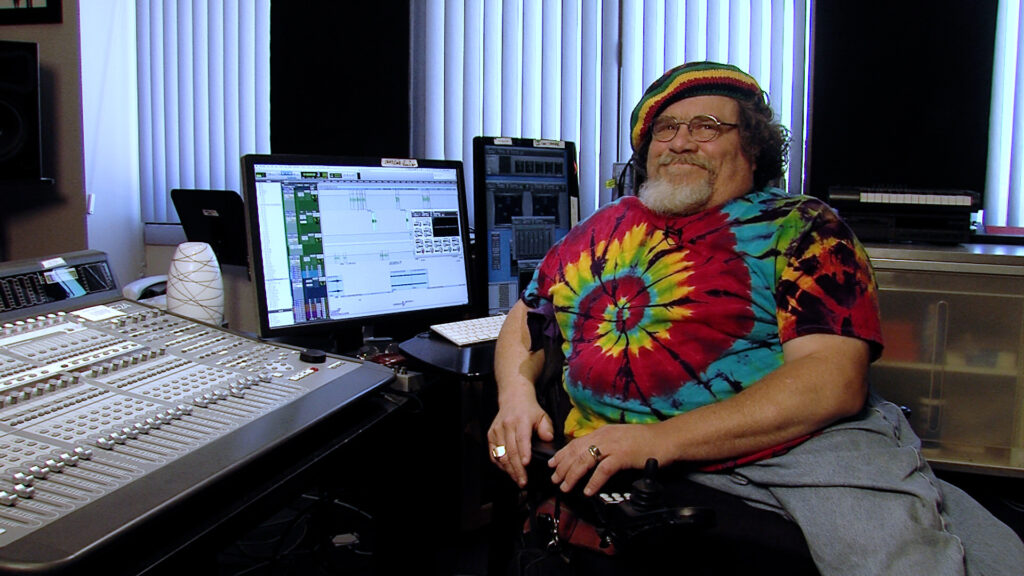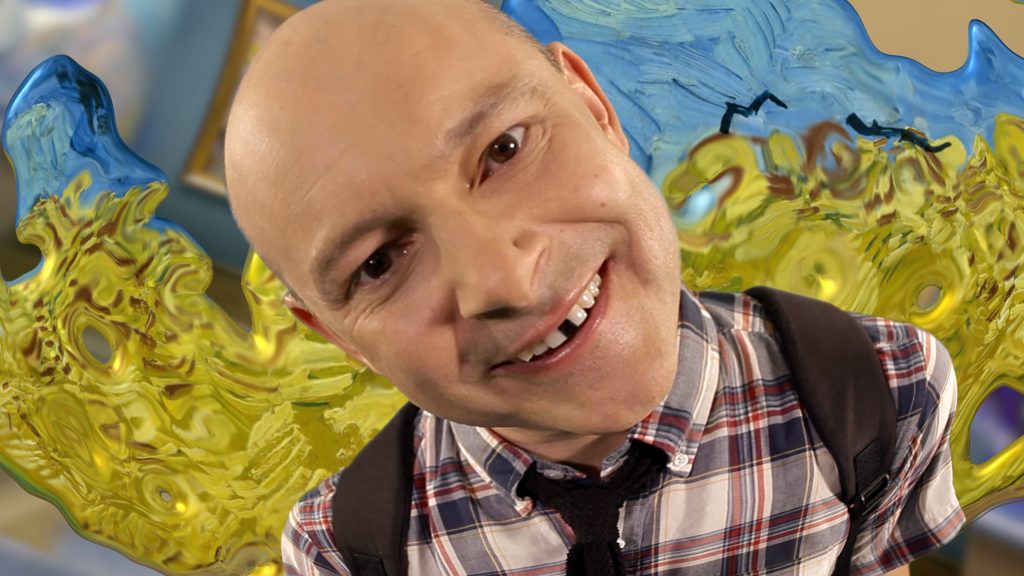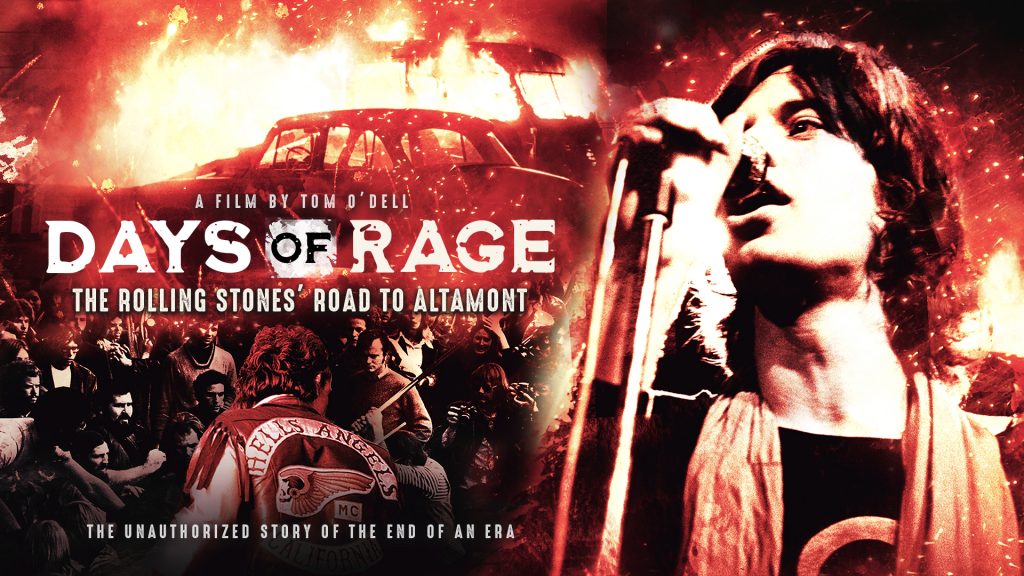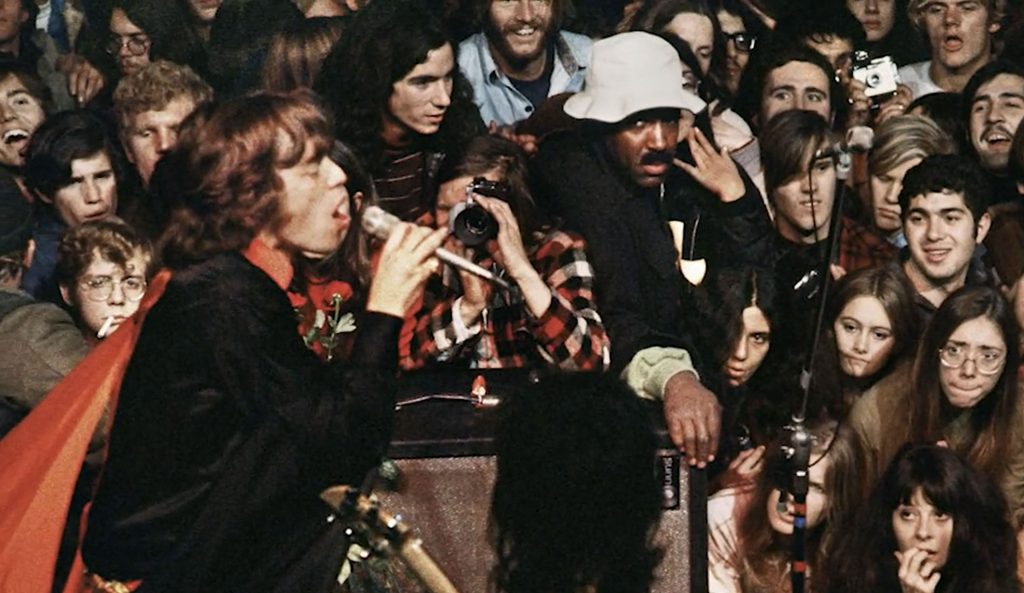June 12, 2022
by Carla Hay

Directed by Lonnie Frazier
Culture Representation: The documentary film “Box of Rain” features an all-white group of middle-aged and elderly Grateful Dead fans discussing how this rock band’s music and culture made a positive impact on their lives.
Culture Clash: Grateful Dead concerts, which were about improvisation and peaceful freedom of expression, inspired the same attitudes in Grateful Dead fans (also known as Deadheads), who are sometimes misunderstood or stereotyped by other people.
Culture Audience: Besides appealing to the obvious target audience of Grateful Dead fans, “Box of Rain” will appeal to people interested in documentaries about unique music-based fandoms.

The documentary “Box of Rain” is an admittedly sentimental love letter to Grateful Dead fans (also known as Deadheads) that doesn’t reveal anything groundbreaking. The movie (directed by Lonnie Frazier, who counts herself as a longtime Deadhead) mostly consists of Deadheads sharing rosy memories of their experiences going to Grateful Dead concerts and how Deadhead culture changed their lives. There’s a lot of hippie nostalgia in the movie (which only interviews Deadheads), but it’s the type of nostalgia that isn’t preachy or too wistful of a bygone era. The movie tends to be repetitive, but it’s also uplifting and celebratory of people finding communities that are positive, which is the overall tone of this fan-oriented documentary.
“Box of Rain” is named after the “Box of Rain” song on the Grateful Dead’s 1970 “American Beauty” album. The documentary is a collection of thoughts and anecdotes from Grateful Dead fans who experienced the San Francisco-based rock band in the decades when the Grateful Dead toured with lead singer/co-founder Jerry Garcia, who died of a heart attack in 1995, at the age of 53. He was staying in a drug rehab facility at the time of his death.
One of the reasons why “Box of Rain” is so appealing is that “Box of Rain” director Frazier made it a personal film to share her own story about how becoming part of the Deadhead community helped her tremendously in healing from trauma. She provides occasional voiceover narration for the movie, and she appears in several of the documentary’s scenes. Frazier is an immensely likable presence in the movie and comes across as completely genuine in wanting to share how much of an impact the Grateful Dead made on her life and on the lives of so many other people.
As Frazier explains in the beginning of the movie, when she was 17 years old, she was violently raped by a group of male students who went to the same high school and whom she had known since they were all in elementary school. This horrific crime happened one night when she accepted a car ride from them after leaving a party. Instead of driving her to her car, these attackers drove her to a field and raped her.
Frazier says in a documentary voiceover: “After that, I felt like I was drowning in hopelessness. I reached out for help, but I was dismissed and sometimes even blamed. I was scared and suicidal. I didn’t feel safe anywhere. When home doesn’t feel like home, where do you go?”
She continues, “I was lucky. I found kindred spirits who showed me what a family can be, and what home can feel like. Being accepted into the Deadhead community had a profound influence on my life. Making this film is my way of thanking them for saving me.”
What was that turning point for her? Frazier says, “It all started with free tickets to see the Grateful Dead and a road trip.” Not long after she was raped and in a very dark place in her life, a friend named Betsy had free Grateful Dead tickets and invited Frazier and another friend to go on a road trip to travel from Maryland to see the Grateful Dead at Red Rocks Amphitheatre in Morrison, Colorado. The concert took place on September 6, 1985 (the documentary briefly shows a ticket stub from the show), and Frazier had just recently gotten a new car, which was used for the road trip.
Frazier says in the documentary that she was so eager to get out of her current living environment, she jumped at the chance to go on the trip, which she took with the two other teenage friends: Betsy Abel-Talbott and Kelly Gallagher. (A grey and white cat was also along for the ride.) Abel-Talbott, Gallagher and Frazier are shown together in a reunion interview that’s fun to watch, as they happily reminisce about this road trip. Abel-Talbott comments, “The trip was an incredible bonding experience for three girls. It was phenomenal.”
Later, in the documentary, Frazier is shown returning to Red Rocks Amphitheatre, which is located in the middle of a natural rock structure, to share more memories of that concert, which was the first time that she saw the Grateful Dead perform. She vividly describes the overwhelming feeling of belonging to a community and feeling immediately accepted by strangers at this concert, which are feelings that she’d never experienced before. Frazier mentions that it feels a little strange that Abel-Talbott and Gallagher weren’t able to go with her on this return to Red Rocks. It was probably because the footage was filmed during the height of the COVID-19 pandemic. People are seen wearing pandemic masks in this Red Rocks footage.
This feeling of belonging to a welcoming community and feeling instantly accepted are recurring themes when people describe Deadhead culture in this documentary. Although some people describe the Deadhead lifestyle as almost like being part of a religion, it has never been a religion or a cult. Cults are defined as having leaders who dictate what cult members do with their lives, with an “us against them” mentality when interacting with people who aren’t in the cult. Deadhead culture is just the opposite, since the overall attitude is to let people be themselves peacefully, and to respectfully let people make up their own minds about what makes them happy.
Still, like any famous band, the Grateful Dead had a lot of fanatical followers, many of whom dropped out of school or quit their jobs to follow the band on tour. Many of these Deadheads also raised families in this lifestyle and sustained themselves by selling art, food, jewelry, T-shirts and/or other memorabilia to get enough money for living expenses and to get to the next Grateful Dead concert. Grateful Dead concerts were also known for their communal scenes in each venue’s parking lot, where there was plenty of partying before and after the concerts. A few people in the documentary briefly mention financial hardships because of the costs of following the Grateful Dead on tour, but it’s all framed in a nostalgic tone of “youthful adventures,” without going into details about any of the harsh down sides to the lifestyle.
The people interviewed in the documentary all consider themselves to be Deadheads with a wide range of experiences. When asked to estimate the number of Grateful Dead concerts they saw in their lives, the lowest number named by one person is 20 to 30, while the highest number named by another person is 400. Grateful Dead concerts were beloved by fans not only because of the Deadhead community but also because the band never played the same set list at each concert. Songs often stretched into improvisational jams and were never played in the same way twice at Grateful Dead shows.
Rev. Joey Talley, who is described as an “old Wiccan minister” in the documentary, is the Deadhead in the movie who estimates that she’s seen about 400 Grateful Dead concerts, starting from the 1970s. She comments on Deadheads traveling around the United States: “We saw the good, the bad and the ugly. And sometimes, we saw bad things done to those places. And that gave us a sensitivity for taking care of the planet.”
It’s no coincidence that many Deadheads are also vegetarians/vegans and environmentalists. However, one of the things that comes up a lot in the documentary is that there are all types of Deadheads. And although it might be tempting to stereotype Deadheads as disheveled hippie types who take psychedelic drugs and are stuck in a “peace and love” Woodstock Festival mindset, the Deadheads in this documentary say that there are many Deadheads who definitely do not fit this stereotype.
For example, Frazier says that she’s never taken hallucinogenic drugs in her life. “Growing Up Dead” author Peter Conners, who became a Deadhead when he was a teenager, comments in the documentary that he’s met many non-Deadhead people who have assumed that his time following the Grateful Dead on tour meant that he had a lifestyle filled with non-stop drug parties and sex orgies. Conners said when he was a young Deadhead, he was definitely interested in dating, but his Deadhead lifestyle wasn’t nearly as decadent as many people assume it was.
Several of the Deadheads in the documentary say that, unlike many rock concerts, Grateful Dead concerts were environments where being physically aggressive and ready to start fights were severely unwelcomed and not allowed to become a problem. Violent and rude people were shunned or removed from Deadhead communities. Deadheads say that treating people with respect and showing kindness to others are core values to Deadhead culture.
The closest that anyone in the documentary comes to criticism of the Grateful Dead is when a few people mention that sometimes the band wasn’t playing at its best at a concert, but that the festive atmosphere from the crowd made up for any disappointing musicianship on stage. A few of the Deadheads in the documentary also gripe about how the Deadhead scene changed (and not for the better) in the late 1980s. They blame this change on the Grateful Dead reaching a new audience because of the band’s 1987 hit “Touch of Grey,” which was popular on the radio and MTV, and which brought a lot of “meatheads” and “macho frat boys” to Grateful Dead concerts.
Because so many of these Deadhead stories have a positive spin, the documentary leaves out a lot of uncomfortable truths about Grateful Dead concerts. For example, no one in the movie talks about overcrowding or drug freakouts at Grateful Dead shows, which were notorious for many attendees being under the influence of psychedelic drugs. No one talks about any legal problems or health problems they might have encountered as a direct result of being a Deadhead, since getting involved in illegal drugs was part of the lifestyle for many Deadheads.
Instead, the documentary has people saying they never saw any violence at Grateful Dead shows they attended. That doesn’t mean nothing unpleasant ever happened at these shows, but the Deadheads in the documentary say that any violence was more likely to come from someone who wasn’t a true Deadhead. Every community has its share of people who behave badly, so it’s not entirely believable that there were no Deadheads who committed violence.
Talley shares a story that happened years ago when she was a young woman at a Grateful Dead concert. She was introduced to a man who was newcomer to the Deadhead scene, and he greeted her with a hug but also by grinding his genitals against her without her consent. When a longtime Deadhead, who had brought this creep to the concert, found out about this sexual assault, Talley says that this protective Deadhead brought the assaulter to Talley and told him to make an apology to her, which the assaulter did. Talley says that was an example of how Deadheads looked out for each other.
Overall, most of the women interviewed in the documentary say that they felt safe at Grateful Dead concerts. Frazier has this to say about becoming part of the Deadhead community, where she could openly talk about her love of art, photography and movies: “It was the first time I felt viewed as a female human being who had things to offer besides what someone could take from me.” Later in the documentary, Frazier begins crying when she comments that after recovering from her rape, becoming part of the Deadhead community restored her faith that most people are essentially good.
However, Conners admits that when he was a young Deadhead, he didn’t really think about how concert experiences could be different for women and the “greater risks” that female Deadheads were “taking with their personal safety … that I took for granted because I had the privilege of being a 6-foot-tall white male moving through the world. I didn’t have to worry about safety issues so much.”
“Box of Rain” admirably brings up an issue that often gets ignored in documentaries about fans of rock concerts: how disabled people experience these concerts. One of the documentary’s interviewees is Oscar-nominated “Crip Camp” co-director Jim LeBrecht, a longtime Deadhead who uses a wheelchair. LeBrecht describes what it was like to go to a Grateful Dead concert before and after 1990’s Americans With Disabilities Act (ADA) outlawed discrimination against people with disabilities, thereby requiring disability access for disabled people in buildings that are open to the public.
Before the ADA (and when most concerts were general admission), wheelchair-using people who went to concerts were usually put in a section in the back where they could see above the crowd but still were far away from the stage, in an era when most concerts didn’t have large video screens. Despite often being treated like second-class concertgoers, LeBrecht says marijuana-using Deadheads in wheelchairs had some “perks” when they went to a Grateful Dead concert: “If you’re ever at a party, and you’re looking for the person with the best pot, you’re looking for the person in the wheelchair, because these folks had great pot.”
The death of Grateful Dead leader Garcia was devastating to many fans, and there’s a section of the documentary that discusses this topic. Tim Zecha, who says he thought of Garcia as being “like a shaman,” gets tearful when he remembers meeting Garcia and being an admittedly “star-struck fan” during this encounter. LeBrecht comments on his own reaction to Garcia’s death: “I don’t think I recovered for a year, because it was the absolute closing of an era in my life.”
Other people interviewed in the documentary include Marty “Ziggy” Leipzig, Johnny Adams, James Talley, Mark Mullis, Jack Gerard, Bob Shugoll, Jen Rund, Kelley Condon, Julie Moore, Jim McWatters and “Deadheads” documentary filmmaker Brian O’Donnell. The “Box of Rain” documentary includes a section where many of the interviewees talk about “magic shows,” a Deadhead term for Grateful Dead concerts that were extraordinarily magical experiences for Deadheads.
The Grateful Dead was the first major rock band to allow fans to record the band’s concerts. It resulted in widespread tape trading among fans who collected recordings of these shows. A section of “Box of Rain” covers the Deadhead tape-trading community. Tape trading seems very quaint now in this digital era where anyone with a smartphone can record concerts and share these digital recordings.
It’s an example of how the Grateful Dead was ahead of its time, because the band let fans record Grateful Dead shows during an era when audience members who were caught recording other artists’ concerts could get expelled or arrested for copyright law violations. Nowaways, it’s become common to go to a concert and see numerous people openly recording it. Entire concerts or large portions of concerts are now uploaded or livestreamed by audience members for people around the world.
In one way or another, the Deadheads interviewed in the “Box of Rain” documentary say that the band’s music, especially at the live concerts, helped them be better people, resulted in great experiences, and got them through tough times. Leipzig, whose husband Michael died of prostate cancer, says that listening to the Grateful Dead’s music was a comfort to her and Michael, while helping them cope during his cancer battle: “I know when we listened to certain songs together, we were moved to another plane of understanding and compassion—so thank you, Grateful Dead.”
Many of the stories told in the documentary will be moving to anyone, especially people who can relate to finding a lot of joy and emotional healing through music. In other words, viewers don’t need to be fans of the Grateful Dead to enjoy the “Box of Rain” documentary. The movie isn’t perfect, but if the intention of “Box of Rain” is to make viewers smile and feel good about humanity, then this documentary definitely succeeds in that purpose.
Mutiny Pictures released “Box of Rain” on digital and VOD on May 3, 2022.




